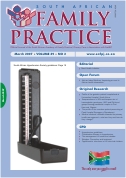Newer Agents for the Management of Overactive Bladder
Keywords:
overactive bladder
Abstract
The anticholinergics tolterodine and oxybutynin are well established in the management of overactive bladder. However, their activity at muscarinic receptors distant from the target site (i.e., bladder) produces anticholinergic side effects leading to poor tolerability. In 2004, trospium, solifenacin, and darifenacin were approved by the U.S. Food and Drug Administration for the treatment of overactive bladder. Trospium is water soluble and therefore is less likely to enter the central nervous system, and solifenacin and darifenacin are more selective for the bladder than older agents. Although these attributes could improve tolerability, clinical trials comparing relevant agents to validate this are lacking. Trials have shown that these newer agents decrease the frequency of incontinence episodes, the number of voids per day, and the number and severity of urgency episodes compared with placebo. These agents also have been shown to improve quality of life in women with overactive bladder and urinary incontinence. Head-to-head studies of the newer agents and immediate-release oxybutynin and tolterodine have suggested similar effectiveness across the class, although the newer agents are better tolerated. Trospium and darifenacin have not been compared with extended-release formulations of tolterodine or oxybutynin, which are better tolerated than the immediate-release versions. In one study, solifenacin produced a somewhat greater decrease in the number of incontinence episodes than extended-release tolterodine, with no difference in tolerability. In general, the newer agents appear to be at least as effective as their predecessors, although it is unclear whether they are better tolerated. Important pharmacokinetic differences among the agents (e.g., route of elimination) allow for selection of an appropriate agent based on individual factors such as cost and tolerability. Permission from the AAFP was granted to publish this article in the hardcopy only. Kindly refer to www.aafp.org or subscribe to the hardcopy of South African Family Practice.
Section
CPD
By submitting manuscripts to SAFP, authors of original articles are assigning copyright to the South African Academy of Family Physicians. Copyright of review articles are assigned to the Publisher, Medpharm Publications (Pty) Ltd, unless otherwise specified. Authors may use their own work after publication without written permission, provided they acknowledge the original source. Individuals and academic institutions may freely copy and distribute articles published in SAFP for educational and research purposes without obtaining permission.

